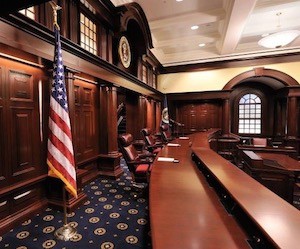Held: The Federal Circuit said inherency analysis requires demonstrating that the natural result from the operation as taught would result in the performance of a claimed function. Inherency, however, cannot be established by a mere possibility or probability that result would occur.
 The Federal Circuit recently reversed a decision of the Patent Trial and Appeal Board (Board) finding claims of a patent owned by PersonalWeb Technologies, LLC to be invalid. Apple, Inc. (Apple) petitioned for inter partes review (IPR), and the Board found certain claims of the patent to be invalid as obvious in light of two references. The Federal Circuit reversed, holding the Board provided insufficient evidence to support a finding of inherency. Pers. Web Techs., LLC v. Apple, Inc., No. 2018-1599, 2019 U.S. App. LEXIS 6919 (Fed. Cir. Mar. 8, 2019) (Before Moore, Taranto, and Chen, Circuit Judges) (Opinion for the Court, Chen, Circuit Judge).
The Federal Circuit recently reversed a decision of the Patent Trial and Appeal Board (Board) finding claims of a patent owned by PersonalWeb Technologies, LLC to be invalid. Apple, Inc. (Apple) petitioned for inter partes review (IPR), and the Board found certain claims of the patent to be invalid as obvious in light of two references. The Federal Circuit reversed, holding the Board provided insufficient evidence to support a finding of inherency. Pers. Web Techs., LLC v. Apple, Inc., No. 2018-1599, 2019 U.S. App. LEXIS 6919 (Fed. Cir. Mar. 8, 2019) (Before Moore, Taranto, and Chen, Circuit Judges) (Opinion for the Court, Chen, Circuit Judge).
PersonalWeb Technologies LLC (PersonalWeb) is the owner of the ‘310 patent, which is directed toward generating a substantially unique content-based identifier for each data item in a data processing system. Apple initially filed for IPR of the ‘310 patent in 2013. In March of 2015, the Board issued a final written decision concluding that certain claims of the ‘310 patent are unpatentable as obvious over a combination of two prior art references—U.S. Patent Nos. 5,649,196 (Woodhill) in view of 7,359,881 (Stefik). PersonalWeb then appealed the Board’s decision to the Federal Circuit.
Back to the Board
On appeal, the Federal Circuit affirmed the Board’s claim construction but vacated and remanded the Board’s obviousness finding for further consideration. The Federal Circuit reached its decision by determining the Board’s analysis regarding obviousness was inadequate, including its analysis of: (1) whether the prior art references disclosed all of the elements recited in the challenged claims and (2) whether a skilled artisan would have been motivated to combine the references in the manner recited in the ‘310 patent.
The main element in dispute in that appeal (as well as the later appeal) was the claim limitation “causing the content-dependent name of the particular data item to be compared to a plurality of values.” The Board cited only Stefik as satisfying this element, but Apple’s petition relied only on Woodhill for this element. Accordingly, the Federal Circuit disagreed with the Board’s use of Stefik and remanded the case with instructions for the Board to consider only whether column 17 of Woodhill, which was the only portion of Woodhill cited by Apple, taught this limitation. The Court also rejected the Board’s motivation-to-combine analysis, which merely affirmed Apple’s allegation that a person having ordinary skill in the art (POSA) “would have allowed for the selective access features of Stefik to be used with Woodhill’s content-dependent identifiers feature.” The Court explained that this reasoning “said nothing more than the two references could be combined, not that there would [have] been a motivation to combine them and lacked any explanation as to how the combination of the two references was supposed to work.”
On remand, the Board maintained the same obviousness theory of unpatentability, except that the Board replaced its previous reliance on Stefik for teaching the “compared to a plurality of values” element of Claim 24 of the ‘310 patent with reliance on column 17 of Woodhill. Specifically, the Board adopted Apple’s experts’ conclusion that Woodhill inherently disclosed the disputed limitation in claim 24, i.e., “Woodhill, without saying so, necessarily compares the content-based identifier (Binary Object Identifier) of the particular data item (binary object) to a plurality of values (an unmentioned but necessarily present database of Binary Object Identifiers).” The Board also elaborated on its analysis of a POSA’s motivation to combination Woodhill and Stefik.
Reversed Again
PersonalWeb again appealed the Board’s decision. On appeal, the Federal Circuit determined the Board’s inherency finding derived from column 17 of Woodhill lacks substantial evidence. The Federal Circuit noted that “[w]hile it is possible that Woodhill’s system utilizes an unstated Binary Object Identifier lookup table to locate binary objects of a previous version of a file that is going to be restored (column 17 of Woodhill), mere possibility is not enough.” Instead, to demonstrate inherency, a party must “show that natural result flowing from the operation as taught would result in the performance of the questioned function.” PAR Pharm., Inc. v. TWI Pharm., Inc., 773 F.3d 1186, 1195 (Fed. Cir. 2014). Because the Federal Circuit determined the Board’s inherency analysis of the aforementioned feature was improper, it reversed the Board’s decision without reaching the question of motivation to combine.

![[IPWatchdog Logo]](https://ipwatchdog.com/wp-content/themes/IPWatchdog%20-%202023/assets/images/temp/logo-small@2x.png)


![[Advertisement]](https://ipwatchdog.com/wp-content/uploads/2024/04/Patent-Litigation-Masters-2024-sidebar-early-bird-ends-Apr-21-last-chance-700x500-1.jpg)

![[Advertisement]](https://ipwatchdog.com/wp-content/uploads/2021/12/WEBINAR-336-x-280-px.png)
![[Advertisement]](https://ipwatchdog.com/wp-content/uploads/2021/12/2021-Patent-Practice-on-Demand-recorded-Feb-2021-336-x-280.jpg)
![[Advertisement]](https://ipwatchdog.com/wp-content/uploads/2021/12/Ad-4-The-Invent-Patent-System™.png)







Join the Discussion
4 comments so far.
Concerned II
March 20, 2019 11:22 amGive legislation a nice-sounding name, market it as “reform,” and the force of big money special interest can almost always have its way with the rest of us, and it certainly did in the case of the AIA. Do we really believe more than a few members of Congress had any real understanding of what was being done to our patent system with this “trojan horse” dubbed the “America Invents Act”?
The PTAB and much of the AIA was a frenzied overreaction to media hype about alleged abuses in the patent system, like the silly “patent troll” thing. A little patience would have seen most if not all of these supposed ills exposed as myth, or adequately addressed in the courts and within the confines of the extant system for adjudicating patent disputes.
A major part of the AIA, reconstitution of the PTAB as some sort of quasi-judicial body, was, is, and always will be a very bad idea. While the members of the PTAB are due great respect and no doubt seek to do their duty with competence and excellence, they are doing so in a fundamentally flawed tribunal. Article III federal courts, and only Article III federal courts, should develop and apply the patent law in the adversarial context of real disputes in which there are Constitutional guarantees. It is that simple.
Continuing to debate the merits of individual PTAB decisions makes it seem like we are giving in to a hydra that is growing in our midst. Does it really matter how many angels can dance on the head of a pin that is being used to prick us to death?
Jonathan Stroud
March 18, 2019 07:06 pmYou missed the most important part—they reversed, but did not remand.
Mark Martens
March 18, 2019 06:08 pmThis difference between the PTAB and the Federal Circuit court seems like an additional problem for inventors?
It doesn’t seem like there anything GOOD for inventors in the ‘America Invents Act’. I suppose this is what is meant by the notion that the titles of legislation are always the opposite of what they do, right. I mean shouldn’t the AIA have been called something like the ‘Assassinate Inventors Act’?
Daniel Hanson
March 18, 2019 10:43 amIt is not immediately clear why this case was designated as precedential. The test for inherency (that more must be shown than that the element is possibly present) was already established in earlier case law; application of inherency analysis to obviousness (and not just to anticipation) broke no new ground; and the deferential standard of review (inherency is a question of fact reviewed for substantial evidence) likewise was not a new pronouncement. So why is this case precedential?
I suspect the answer may be that the case discusses a way effectively to rebut inherency. If the cited reference does not necessarily disclose the element in question, and if the cited reference plausibly encompasses something quite different from the element in question, then there is no inherency. Even applying a very deferential standard of review, a plausible alternative supported by the record is fatal to a finding of inherency. Furthermore, if a practical absurdity results when one supposes that the reference includes the element (see footnote 5 of the opinion), then that is just icing on the cake.